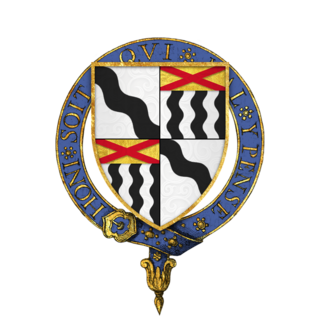| Earldom of Portsmouth | |
|---|---|
  Wallop arms: Argent, a bend wavy sable Crest :A mermaid holding in the sinister hand a mirror and in the dexter a comb all proper supporters :On either side a chamois or wild goat sable | |
| Creation date | 11 April 1743 |
| Created by | George II |
| Peerage | Peerage of Great Britain |
| First holder | John Wallop, 1st Earl of Portsmouth |
| Present holder | Quentin Wallop, 10th Earl of Portsmouth |
| Heir apparent | Oliver Henry Rufus Wallop, Viscount Lymington |
| Remainder to | 1st Earl's heirs male of the body lawfully begotten. |
| Subsidiary titles |
|
| Seat(s) | Farleigh Wallop |
| Former seat(s) | |
| Motto | EN SUIVANT LA VERITÉ (In following the truth) |

Earl of Portsmouth is a title in the Peerage of Great Britain. It was created in 1743 for John Wallop, 1st Viscount Lymington, who had previously represented Hampshire in the House of Commons. He had already been created Baron Wallop, of Farleigh Wallop in Hampshire in the County of Southampton, and Viscount Lymington, in 1720, also in the Peerage of Great Britain.
Contents
The second earl was the son of Catherine Conduitt, whose mother was Catherine Barton, half-niece of the eminent mathematical scientist Sir Isaac Newton. The earls of Portsmouth therefore are direct descendants of Isaac Newton's mother, and three of the earls have been named after Newton. The earls were in possession of a large trove of Newton's personal papers, until they were auctioned in 1936. Those documents are commonly known as the "Portsmouth Papers". [2]
The third Earl declared himself King of Hampshire and his brother had him declared insane. [3]
The fourth Earl represented Andover and Devonshire North in Parliament. In 1794, he assumed by Royal licence for himself and his issue the surname and arms of Fellowes only.
The fifth Earl resumed, without Royal licence, the family surname and arms of Wallop.
The sixth Earl represented Barnstaple in Parliament as a Liberal.
Oliver Henry Wallop, the eighth Earl, had moved from England to the United States, and been living the life of a rancher in Sheridan, Wyoming, at the time of the death of his older brother, the seventh Earl. Known as O.H. Wallop, he had served two terms a state representative in the Wyoming Legislature. [4] He had become an American citizen in 1891, and was allowed to take his seat in the House of Lords only after renouncing American citizenship. [5]
The ninth Earl sat as Conservative Member of Parliament for Basingstoke.
The current holder is Quentin Wallop, 10th Earl of Portsmouth, who succeeded in 1984, is the only son of Oliver Kintzing Wallop, Viscount Lymington (1923–1984).
The American politician Malcolm Wallop was a grandson of the 8th Earl.
The family seat is Farleigh House, near Basingstoke, Hampshire.







